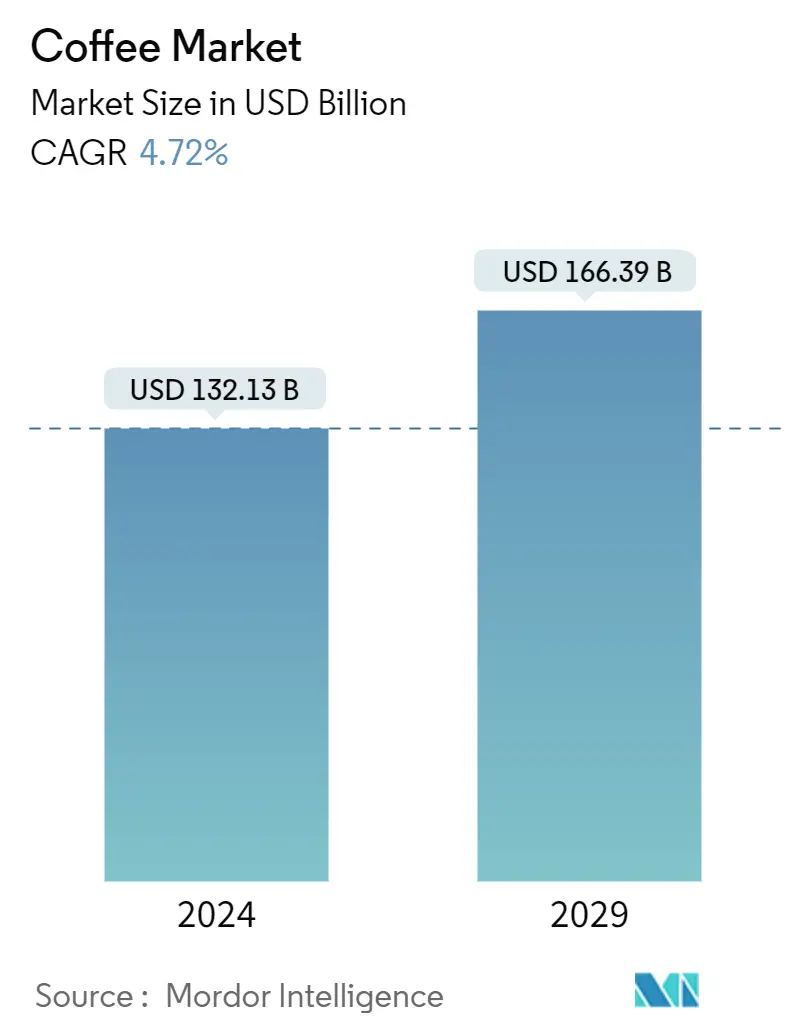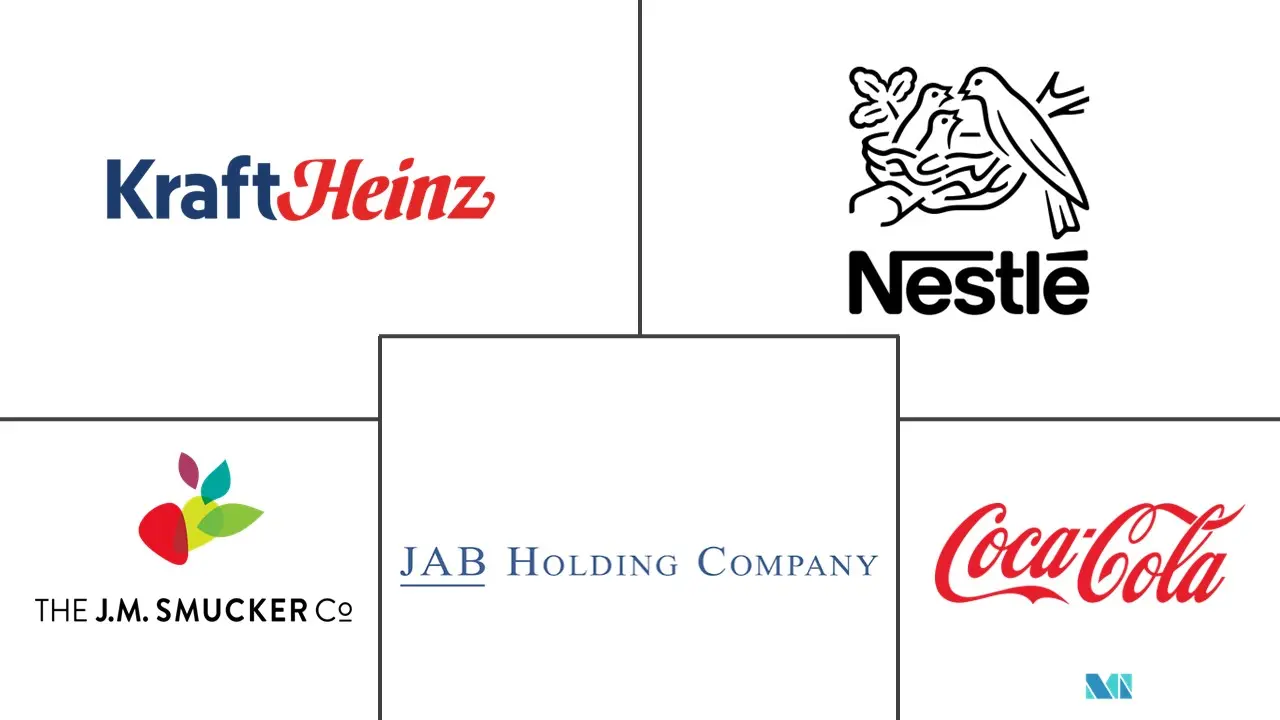Market Size of Coffee Industry

| Study Period | 2019 - 2029 |
| Market Size (2024) | USD 132.13 Billion |
| Market Size (2029) | USD 166.39 Billion |
| CAGR (2024 - 2029) | 4.72 % |
| Fastest Growing Market | South America |
| Largest Market | Europe |
Major Players
*Disclaimer: Major Players sorted in no particular order |
Coffee Market Analysis
The Coffee Market size is estimated at USD 132.13 billion in 2024, and is expected to reach USD 166.39 billion by 2029, growing at a CAGR of 4.72% during the forecast period (2024-2029).
- The coffee market is rising due to the growing culture of consuming coffee as a refreshing drink among the younger population, especially in India, Italy, the United States, China, Japan, and the Philippines. In addition, the increasing disposable income coupled with urbanization is the primary factor contributing to the growth of the coffee market. On the other hand, the various health benefits of consuming coffee, such as reducing the risk of diabetes, burning fat, and consuming high energy from caffeine spikes, are also driving the market growth.
- Consumers are shifting towards more organic or plant-based coffee to maintain a healthy lifestyle. Hence, key players are engaged in product innovations to maintain a stronger foothold in the market. For instance, in 2021, Nestle Japan launched a range of Nescafé lattes, including coffee capsules crafted with plant-based ingredients, to meet consumers rapidly growing interest in plant-based food. In addition, another significant factor driving the market growth is busy lifestyles, leading to coffee chains becoming more popular among customers who enjoy their coffee on the go.
- Consumers demand premium products that emphasize quality. Therefore, they are attracted to top-notch coffee houses that offer the best coffee quality, which is a significant factor for repeated visits. Technology innovations, safety measures, and machine-based food processing units are projected to play an essential role in the demand for coffee over the coming years.
Coffee Industry Segmentation
Coffee is a brewed drink prepared from roasted coffee beans, the seeds of berries from certain flowering plants in the Coffea genus.
The global coffee market is segmented by product type, distribution channel, and geography. By product type, the coffee market is segmented into whole-bean, ground coffee, instant coffee, and coffee pods and capsules. Based on the distribution channel, the market is segmented into on-trade and off-trade. The off-trade channels include supermarkets/hypermarkets, convenience stores, specialist retailers, and other channels. The report provides an analysis of emerging and established economies across the world, comprising North America, Europe, South America, Asia-Pacific, and Middle-East and Africa.
The market sizing has been done in value terms in USD for all the abovementioned segments.
| Product Type | |
| Whole-bean | |
| Ground Coffee | |
| Instant Coffee | |
| Coffee Pods and Capsules |
| Distribution Channel | ||||||
| On-trade | ||||||
|
| Geography | |||||||||
| |||||||||
| |||||||||
| |||||||||
| |||||||||
|
Coffee Market Size Summary
The coffee market is experiencing significant growth, driven by the increasing popularity of coffee as a refreshing beverage among younger consumers in countries like India, Italy, the United States, China, Japan, and the Philippines. This trend is further supported by rising disposable incomes and urbanization, which are key factors fueling market expansion. Additionally, the health benefits associated with coffee consumption, such as reduced diabetes risk and increased energy from caffeine, are contributing to the market's upward trajectory. Consumers are increasingly seeking organic and plant-based coffee options, prompting major players to innovate and introduce new products to cater to this demand. The busy lifestyles of consumers are also boosting the popularity of coffee chains, which offer convenient on-the-go coffee solutions.
The demand for ethically produced coffee is on the rise, with organic certification gaining traction, particularly in Asia and Europe. Consumers are increasingly aware of the origins and production methods of their coffee, leading to a preference for certified sustainable coffee products. This shift is supported by various certification bodies that ensure coffee meets specific social, environmental, and economic criteria. The Asia-Pacific region, traditionally a tea-drinking area, is witnessing a surge in coffee consumption, with countries like Japan and China showing significant growth in coffee imports and consumption. The competitive landscape of the coffee market is dominated by major players such as Nestlé S.A., Kraft Heinz Company, and JAB Holding Company, who are expanding their market presence through product innovations and strategic partnerships.
Coffee Market Size - Table of Contents
-
1. MARKET DYNAMICS
-
1.1 Market Drivers
-
1.1.1 Increased Coffee Consumption Among Working Population
-
1.1.2 Coffee Pods and Capsules Demand Augmenting the Market Growth
-
-
1.2 Market Restraints
-
1.2.1 Trade barriers Restrict Access to Developed Markets
-
-
1.3 Porter's Five Forces Analysis
-
1.3.1 Bargaining Power of Suppliers
-
1.3.2 Bargaining Power of Buyers/Consumers
-
1.3.3 Threat of New Entrants
-
1.3.4 Threat of Substitute Products
-
1.3.5 Intensity of Competitive Rivalry
-
-
-
2. MARKET SEGMENTATION
-
2.1 Product Type
-
2.1.1 Whole-bean
-
2.1.2 Ground Coffee
-
2.1.3 Instant Coffee
-
2.1.4 Coffee Pods and Capsules
-
-
2.2 Distribution Channel
-
2.2.1 On-trade
-
2.2.2 Off-trade
-
2.2.2.1 Supermarkets/Hypermarkets
-
2.2.2.2 Convenience Stores
-
2.2.2.3 Specialist Retailers
-
2.2.2.4 Other Distribution Channels
-
-
-
2.3 Geography
-
2.3.1 North America
-
2.3.1.1 United States
-
2.3.1.2 Canada
-
2.3.1.3 Mexico
-
2.3.1.4 Rest of North America
-
-
2.3.2 Europe
-
2.3.2.1 Germany
-
2.3.2.2 United Kingdom
-
2.3.2.3 France
-
2.3.2.4 Italy
-
2.3.2.5 Russia
-
2.3.2.6 Spain
-
2.3.2.7 Rest of Europe
-
-
2.3.3 Asia-Pacific
-
2.3.3.1 India
-
2.3.3.2 China
-
2.3.3.3 Australia
-
2.3.3.4 Japan
-
2.3.3.5 Rest of Asia-Pacific
-
-
2.3.4 South America
-
2.3.4.1 Brazil
-
2.3.4.2 Argentina
-
2.3.4.3 Rest of South America
-
-
2.3.5 Middle East & Africa
-
2.3.5.1 United Arab Emirates
-
2.3.5.2 South Africa
-
2.3.5.3 Rest of Middle East & Africa
-
-
-
Coffee Market Size FAQs
How big is the Coffee Market?
The Coffee Market size is expected to reach USD 132.13 billion in 2024 and grow at a CAGR of 4.72% to reach USD 166.39 billion by 2029.
What is the current Coffee Market size?
In 2024, the Coffee Market size is expected to reach USD 132.13 billion.

